This is a Tanack Type-V3, a 35mm rangefinder camera made in Japan by Tanaka Optical Co., Ltd. in 1959. The Tanack Type-V3 was the last commercially released camera made by Tanaka, who was known for a series of Leica rangefinder copies which they made throughout the 1950s. The Tanack Type-V3 is unique among all other Tanack cameras, and even other Japanese Leica copies, in that it has its own unique bayonet lens mount. Strangely, no lenses were ever made for this mount, and all version of the camera sold had regular Leica Thread Mount lenses screwed into an adapter. Other than the lens mount, the Tanack Type-V3 is typical of late 1950s interchangeable lens Japanese rangefinder cameras in that it has a combined coincident image rangefinder, film advance lever, a hinged film compartment and a modern design.
Film Type: 135 (35mm)
Lens: 5cm f/1.9 Tanaka Kogaku Tanar coated 6-elements in 4-groups
Lens Mount: Tanack V3 Bayonet w/ M39 LTM Adapter
Focus: 2 feet / 0.6 meters to Infinity, 3.3 feet / 1 meter to Infinity (Rangefinder Coupled)
Viewfinder: Coincident Image Coupled Rangefinder, 95% Field of View, 0.8x Magnification
Shutter: Cloth Focal Plane
Speeds: T, B, 1 – 1/500 seconds
Exposure Meter: None
Battery: None
Flash Mount: Accessory Cold Shoe and F and X Flash Sync, 1/25 X-Sync
Other Features: None
Weight: 726 grams, 532 grams (body only)
Manual (Similar Model): https://www.cameramanuals.org/pdf_files/tanack_type_iv_s.pdf
How these ratings work |
The Tanack Type-V3 was a last ditch effort by a company on the verge of going to of business, but turns out to be a really nicely made and high quality camera. Despite using a bayonet lens mount not supported by any lenses, the camera works with LTM lenses and has a very good build quality, excellent ergonomics, and is as fun to shoot as it makes good photos. This isn’t a camera you’re bound to find often, but if you do, proves to be a capable shooter. | ||||||
| Images | Handling | Features | Viewfinder | Feel & Beauty | History | Age | |
| 2 | 2 | 1 | 1 | 2 | 1 | 20% | |
| Bonus | None | ||||||
| Final Score | 10.8 | ||||||
History
Collectors of Japanese cameras are well aware of the vast number of Leica Thread Mount rangefinder cameras produced by a large number of companies in the mid 20th century. Everyone from Canon to Nicca to Minolta made a camera that used the venerable 39mm screw mount which made its debut with the Leica Model C in 1930.
While finding excellent cameras which copied the successful formula used by Ernst Leitz is pretty easy from the larger companies, dedicated collectors also search for those by lesser known companies like Melcon, Chiyotax, Honor, and Tanack. What separates the various models of each of these companies isn’t great. Those without a keen eye could easily mistake a Nicca from a Leotax, but for each of these companies, the differences are in the details. Of the lesser known companies, Tanack cameras evolved the most, with the last model eschewing the 39mm LTM and going with a new bayonet mount, something even Canon didn’t do.
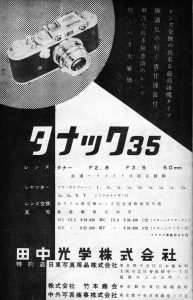
Tanack cameras were produced between 1952 and 1959 by Tanaka Kōgaku K.K. in Tokyo, Japan and was founded by a former employee of Nicca who has ties to Kumagai Genji, who himself had ties to Canon’s predecessor, Seiki Kogaku. The company’s first camera was called the Tanack 35, and like almost every other Japanese Leica copy, was based off the Leica III, featuring separate rangefinder and viewfinder windows, a cloth focal plane shutter with and without slow speeds, a top 1/500 speed, and using the 39mm Leica Thread Mount. The Tanack 35 is closest to the prewar Leica IIIb, suggesting that more advanced German models were either not easy to get in postwar Japan for inspiration, or that these earlier models were easier to copy. Most cameras are found with a collapsible 50mm f/3.5 Tanar lens, but later versions had faster f/2.8 and f/2 lenses.
Despite only being produced for just over 7 years, there were a large number of different Tanack models, many of which had specs and model numbers which closely matched that of competing Japanese camera makers like Canon and Nicca. Models like the IIC, IIIC, IIF, IIIF, IIIS and IIISa were all released between 1952 and 1955 offering incremental improvements and faster lenses.
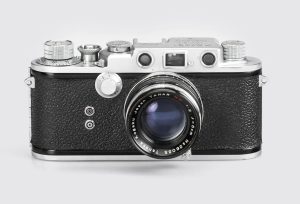
In early 1955, a new model called the Tanack IV-S was released. It was not significantly different from earlier cameras, only adding strap lugs, a film plane indicator, and revised cosmetics, but was the best selling Tanack model with the highest number built. If you were to find a Tanack camera today, there is a good chance it will be a Tanack IV-S.
Perhaps taking a cue from the Meguro Kōgaku Melcon II which had a resemblance to the Nikon S2, in 1957, a new model called the Tanack SD would appear that shared some similarities to the Nikon. Adding a combined coincident image rangefinder, but still using the 39mm Leica Thread Mount, the Tanack SD and Tanack IV S were sold at the same time, with a slightly higher price for the SD model.
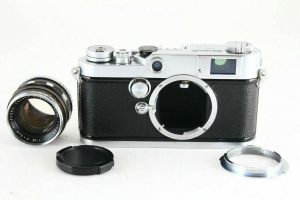
In 1959, a new model called the Tanack Type-V3 was released with an entirely new die cast body with film advance lever, combined coincident image rangefinder and cleaner top plate similar to the Tanack SP, Honor SL, and Canon VI and L series. The camera’s shutter used curtains made out of a fiberglass-like material that was said to be as strong and burn resistant to the titanium curtains used by other Japanese camera makers.
Another major change was that Tanack Type-V3 no longer used the 39mm Leica Thread Mount, instead featuring a 3-lug bayonet mount that was unique to that one camera. According to documentation available at the time, only two prototype lenses were made in the mount, both 5cm Tanars, one f/1.9 and the other f/2.8. A LTM to Tanack bayonet adapter was also available, allowing for full compatibility with any LTM screw mount lens available.
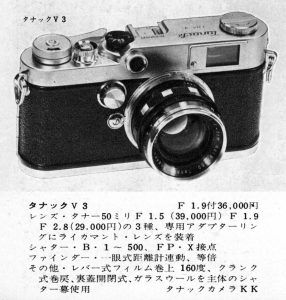
In the July 1959 advertisement to the right for the Tanack Type-V3, a version including a Tanar H.C. 5cm f/1.5 lens was offered for ¥39,000, but all examples of this lens that have been found all have the LTM screw mount, rather than the V3’s bayonet. It is not clear if a bayonet version was planned but never built, or if the lens would have included the LTM adapter when it was sold.
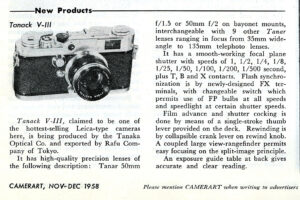
Whatever the fate of the f/1.5 Tanar lens, of the Tanack Type-V3s that have been found, almost all have an M39 LTM 5cm f/1.9 Tanaka Kogaku Tanar lens with the M39 to bayonet adapter. It is commonly believed that while in development and prototype stages, Tanaka had planned on releasing this camera with bayonet mount lenses, but financial troubles required them to abandon that plan in the 11th hour and instead release the camera with screw mount lenses and the bayonet adapter.
Perhaps realizing that a low production camera with a proprietary bayonet lens mount might be a tough sell, one final model called the Tanack VP was produced which had a revised top plate with slightly larger viewfinder windows, but more significantly, retained the 39mm Leica Thread Mount instead of the bayonet mount of the V3.

The Tanack V3 was produced in very limited numbers, with less than 1500 thought to have been made. The Tanack VP is even rarer as the camera was never officially put up for sale and only a few surviving examples are known to exist. It is plausible that the VP was intended for wider production, but financial troubles which by the end of 1959 caused the company to go out of business, prevented the VP from ever officially hitting the market.
As best as I can tell, by the end of the decade, Tanaka Kōgaku had gone out of business. Unlike Nicca, who was one of their closest competitors, the company was not acquired by another Japanese company like when Yashica bought Nicca. It would seem that the assets and history of Tanack faded into history as there does not seem to be any evidence that the company was still around by 1960.
The most obvious reason was a swift change in preference from rangefinders to SLRs, and an increase in competition among Japanese camera makers. By 1960, you needed to have an SLR to stay competitive, and if you didn’t, you needed to make something other than rangefinders, both things that weren’t true about Tanaka Kōgaku, Leotax, Honor, and a bunch of other Japanese companies.
Today, most Leica copies and anything even remotely close to a Leica copy are extremely desirable by the collector and users markets. An interesting characteristic of these cameras is that all of them veered away from the original Leica formula, but kept build quality high enough and with the addition of more modern features like film advance levers, hinged backs, and eventually things like exposure meters, Japanese Leica copies are still great cameras to shoot. If you have a camera that’s been well taken care of throughout the years, it makes for an excellent camera to use, capable of making great photos.
All Tanack cameras have some level of desirability in the collector’s market, but the rarer examples like the Tanack Type-V3 are at the top of the list. With no more than 1500 ever made, excellent looks, performance, and reputation, this is a hard camera to find. If you manage to come across one and want to use it, consider yourself lucky!
My Thoughts
When you look at the evolution of the original Leica and the massive number of Leica copies produced over the year, you can see a reluctance from the original company to change much of the original formula, but for Japanese makers, the desire to improve the design was much more apparent.
To see improvements to the original design, you really only need to look at Canon. From the very start, Canon’s 35mm interchangeable lens rangefinder cameras were more Leica inspired, rather than Leica copies in that the original models didn’t even use the Leica Thread Mount. When they did, the bodies were angular, lacking the rounded edges of the original. Canon quickly improved the viewfinder, adding in a rotating prism which allowed you to change focal lengths within the viewfinder, giving support to more than just 50mm lenses. In the mid 1950s, Canon changed the entire top plate cosmetics of the camera, added film advance levers, hinged backs, tigger film advances, and even exposure meters.

Canon wasn’t the only ones who innovated as Nicca, Leotax, and Tanack eventually got away from that original design with cameras that looked more different than they did the same.
For Tanack, progress was slow but steady. With each new model, the original formula evolved, sometimes tweaking just one feature at a time. It wouldn’t be until the very last days of the company before Tanack made a significant departure from the original Leica III design that nearly every Japanese company copied.
The Tanack Type-V3 is an interesting camera among Japanese Leica copies as other than the original prewar Canons, it is the only Leica inspired Japanese camera to change lens mounts to something new. If you’ve read the history section above, you’ll already know that the Tanack’s new mount was too little too late and lenses using it only existed in prototype form. By the time the camera was sold standard M39 Leica Thread Mount lenses were mounted to the camera via an adapter. Still, it is an interesting little niche of Japanese camera history that would have been fascinating to see continue to evolve.
Despite being one of the company’s last cameras, at a time where quality control might have slipped, the Tanack Type-V3 feels like a very well put together camera. Comparing it to lesser models made by other companies, the Tanack feels at least as good as the best Canon and Niccas I’ve handled. Its feature set, with the combined image coupled rangefinder, lever film advance, and bayonet mount means it compares more to the Leica M3 than the Leica III, but I would hesitate to say this camera is anywhere close to a serious competitor to the Leica M3. If anything, its general shape and list of features compares it closer to a Canon P than anything made in Germany.

Fit and finish is superb, the chrome plating seems very well put on, but is a bit shinier than other cameras of the era. I usually associate shiny chrome finishes with lower end cameras, but that does not appear to be the case here. All of the camera’s controls including the film advance lever, shutter speed selector, and both the focus and aperture rings on the lens all feel high quality, without any unnecessary wobble or looseness. This particular camera came to me in excellent condition and likely saw little use, which certainly contributes to its good condition, but I feel safe saying that even with regular use, the Tanack Type-V3 feels like a camera that should last a very long time.
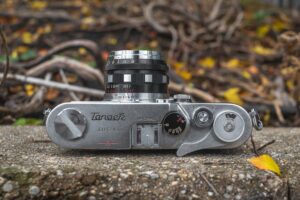
Up top, the Tanack Type-V3 starts with a simple, but large rewind knob with folding handle. The one here doesn’t have any additional features and can’t fold flush into the top plate like some others can, but I’ve found many instances where camera makers get creative with rewind knobs and they don’t always succeed. In this case, I feel like ‘less is more’. Next is the camera’s engraved name, serial number, and film plane indicator. A standard looking accessory shoe sits a little lower, so that the top is flush with the left side of the top plate.
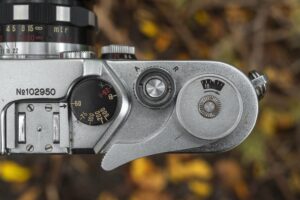
On the same level as the accessory shoe is a black shutter speed selector. with fast speeds plus Bulb engraved in white, ’25-1′ engraved in red, and X in green. You must first cock the shutter before changing speeds, not because it will damage the camera, but that the correct speed will not be aligned with the market. Changing shutter speeds requires you to lift up on the knob and turn it to a speed which lines up with a line on the edge of the accessory shoe. The shutter speed dial is a single piece, but does rotate as you advance and fire the shutter, so you must take care to not let your fingers interfere with the dial as you fire the shutter as it will throw off the movement of the shutter curtains.
Next, on an even lower part of the top plate is the shutter release button with a metal A/R collar around it for enabling or disabling the transport. Turn it to “A” to advance the film and “R” to rewind. The shutter release button is externally threaded for Leica style cable releases and cannot use an internally threaded cable. The location of the shutter release is closer to the front edge of the plate, which for me, is a much more natural feeling and comfortable position, compared to genuine Leicas or other early Japanese copies. Finally, there is the film advance lever with combined exposure counter in the middle. The film advances with a smooth but firm operation, and the exposure counter is additive and must be manually reset to ‘0’ after loading in a new roll of film.
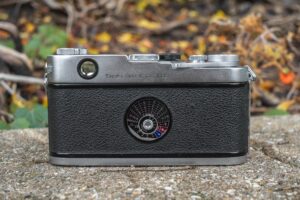
The back of the camera has a moderately large dial in the center of the door which doubles as a film speed reminder, but also a flash distance calculator. While I’m not one to use flashes on old cameras often, this likely would have been a useful feature for people who did. On the back of the top plate is the large round opening for the viewfinder and next to that is an engraving reminding you the name of the company who made it.
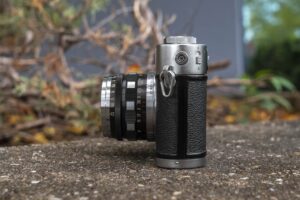
Both sides of the camera have nice rounded edges which makes handling the camera comfortable and both have forward angled metal strap lugs. Having the lugs in this orientation helps balance the camera with heavy lenses attached. On the left side is a flash sync speed switch with selections for F and X. Next to that is the flash sync terminal. I’ve always appreciated cameras in which the flash cable attaches to the side, rather than the back as it feels like it always gets in the way on those cameras.
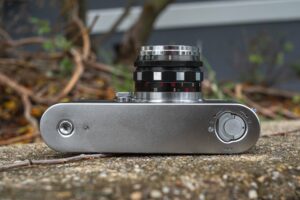
The base of the camera looks like most other bottom loading Leica style rangefinders, except it is not a bottom loader. There is a 1/4″ tripod socket on one side and the film door release lock on the other. The style of film door release also doubles as a key for opening reloadable Leica style cassettes in which the cassette closes as you remove it from the camera. When using regular disposable cassettes, the key just opens the door.
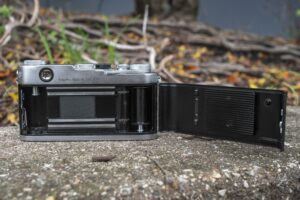
With the right hinged door open, the film compartment is very typical for a late 1950s 35mm camera with no surprises. Film transports from left to right onto a non-removable metal take up spool. Twin film rails above and below the film gate and a large dimpled film pressure plate help reduce friction as film passes through the camera. The Tanack Type-V3 predates the use of foam light seals, so cloth seals on the door hinge and in the door channels still do their job and shouldn’t need replacement, although I always recommend they be inspected.
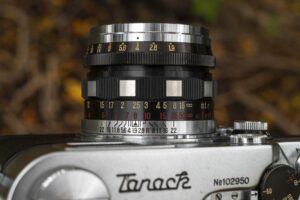
The original Tanar 5cm f/1.9 lens is a classic all brass and glass Japanese design with a German-esque zebra stripe pattern on the focus ring. This is a gorgeous lens both externally and internally. Like most LTM lenses, the focus index on the lens is angled toward the left side of the camera. A fixed depth of field scale is closest to the body with wide the focus ring next. Distances from 0.6 meters and 2 feet to infinity are marked. You should be aware that the Tanack 5cm f/1.9 lens focuses closer than the rangefinder coupling allows similar to the Nippon Kogaku Nikkor-HC 5cm f/2 lens. The color of both the meter and feet scale switches from red to white and white to red at the 3 feet and 1 meter mark to indicate where the rangefinder coupling ends. While looking through the viewfinder, you’ll notice that the rangefinder patch stops moving closer than 3 feet. I find that focusing on something less than 3 feet away without the use of a rangefinder to be very difficult, although it is possible if you want to try. In front of the focus ring is the aperture ring with click stops from f/1.9 to f/22.

The Tanack Type-V3 was designed for its own unique bayonet lens mount, to which only prototype lenses were ever made for the camera. This example, along with every one I’ve seen uses a bayonet to LTM adapter on the camera which can be removed. To remove the bayonet adapter, a Leica M style lens release is at the 9 o’clock position around the lens. If all you want to do is remove the lens from the adapter, you don’t need to use this button, simply unscrew the lens as you would any screw mount lens, but this button is required to remove the adapter. With the lens removed, you can see the round rangefinder coupling which works both with screw and bayonet mount lenses.
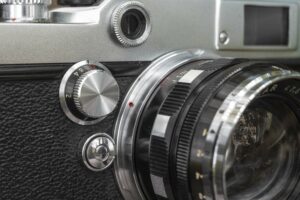
The large mouth of the Tanack’s lens mount is a stark departure from the smaller 39mm opening on most Leica inspired cameras. Above and to the left of the lens mount is the slow speed dial, which has marks for 1 second, through 1/25 seconds plus T. Each mark has a strong click stop, reducing accidental speed changes. Like most cameras with a front slow speed dial, the slow speeds are not used unless the fast speed dial on the top plate is set to the red 25-1 mark. Curiously, there is no setting in between 1/8 and 1/25 seconds.

The Tanack Type-V3 viewfinder is pretty standard for mid 1950s Japanese rangefinders, unfortunately, that this camera was released in 1959 when people started to expect more results in one of my least favorite parts of what is an otherwise great camera. To be clear, the viewfinder is decent, it is big and bright and the rangefinder patch has good contrast making it easy to see in all but the dimmest light. My issue is that compared to what Canon and other companies were doing by 1959, the Albada type frame lines which are etched into the rear eyepiece glass and reflected into the front glass are comparatively dim, and prone to desilvering which makes them even harder to see. That, combined with other companies like Canon and Nikon who were including multiple focal lengths and automatic parallax correction leaves the view through the Tanack feeling cheap and outdated.
Despite an underwhelming viewfinder, the Tanack Type-V3 has more good than bad. This is a well made and competent camera. Tanaka Kogaku’s lenses compare favorably to other A-list Japanese optics companies, the build quality of the Type-V3 is superb, with excellent fit and finish, and modern (for the late 1950s) ergonomics that make it a joy to use. I knew that after this camera came to me, that this was one I wanted to take on a test drive. So I did! You know what comes next…
My Results
The Tanack Type-V3 was one of those cameras that quickly rose to the top of the “to shoot” queue. I was enamored by its good looks, but most importantly, excellent condition. This was a camera that appeared to have been used very little throughout its life and was in excellent cosmetic and operating condition. The lens and viewfinder was clear, the rangefinder looked accurate, and the shutter had no pinholes and sounded like it was firing correctly at all speeds. Of course, a positive initial inspection doesn’t always guarantee perfect operation, but the only way I’d find out is to use it. So I loaded into the camera not one, but two different rolls of fresh Fuji Superia X-tra 400 and took it out shooting over winter 2024.
Before I go any farther, I should probably address the question “Hey Mike, I thought you said both these rolls were Fuji Superia X-tra 400? Why are some of these black and white? Well, the answer to that question is, they were both color film…I’m just a bonehead and misloaded my tank with one of the color rolls while developing a batch of black and white film in HC-110.
As it would turn out. Fuji Superia X-tra 400 is pretty awesome when developed as a black and white film! The developed film still had the characteristic brown base like color films do and I could see a good deal of contrast. When scanning, the contrast was a tad flat, but nothing a few sliders in Photoshop CC couldn’t help with. The resulting images came out quite nice! The thing that amazed me the most was how little grain there was. When viewed on a 32” desktop monitor, the grain looked to be less than what I am used to seeing with 400 color film when developed correctly! Anyway, my accident worked out this time, but your mileage may vary.
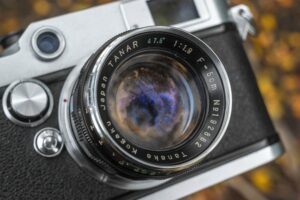
User errors aside, the rest of the camera was quite good. In addition to being an adept camera maker, Tanaka Kogaku was also an optics company that had experience producing lenses for other companies. It is not uncommon to find other Japanese cameras made by Leotax or Nicca with Tanaka’s LTM lenses mounted, but the company also produced lenses using the Contax mount for both Contax and Nikon rangefinders. Like most Japanese optics companies of the day, Tanaka’s lenses were quite good, and it shows in the images I got with the Tanack Type-V3’s 5cm f/1.9 Tanar lens. Image sharpness was excellent across the frame without any noticeable softness or vignetting near the corners. The lens performed similarly to other 6-element sub f/2 rangefinder and SLR lenses of the era.
Earlier in this review I suggested that the Tanack Type-V3 compares favorably to the Canon P, and after shooting the camera, I still think that is mostly true. The “P” in Canon P means “Populaire” as it was designed to have the most popular combination of features, while still being sold at a price that most people could afford, and it seems that the designers of the Tanack Type-V3 took a very similar approach. The Tanack certainly has some differences, most notably the bayonet lens mount and that it still uses a separate dial for slow shutter speeds, but otherwise the two cameras are remarkably similar in features, ergonomics, and quality.
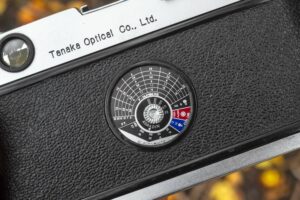
Each of the camera’s controls, from the motion of the film advance lever, changing of shutter speeds, and controlling focus and aperture on the lens were smooth and purposeful with no grit, stiffness, or wobble. In fact, the camera was so smooth and worked so well that if you were to tell me that this would be the second to last camera produced by a company who would go out of business less than a year after its release, I wouldn’t believe you. The Tanack Type-V3 has the feel and operation of a camera made at the peak of a company’s best years, not the last.

The biggest miss with this camera is definitely the bayonet lens mount, of which no lenses were made in any great quantity. Could a bayonet mount 35mm rangefinder with a wide selection of lenses, a large and bright viewfinder and rangefinder, an accurate shutter, and modern controls been successful in the 1960s and beyond? Leitz certainly accomplished it with their Leica M-Series, and although it still used the LTM, the Canon 7 sold in very high numbers and was produced for quite a long time.
I have used a large number of interchangeable lens Japanese rangefinders, and while they have all been good, the Tanack Type-V3 is second only to the Canon 7 in terms of potential. It is quite sad to me that this was the swansong of the company as I really think they were onto something. I feel that with a bit more time, a following Tanack Type-V4 would have been a very exciting camera! Yes, one final camera called the Tanack VP came after the Type-V3, but it was actually a scaled down camera in most regards. Still, I am very happy to have had the opportunity to shoot this camera and can’t wait to load in some film and shoot it again!
Related Posts You Might Enjoy
External Links
http://camera-wiki.org/wiki/Tanack_V3_and_VP
https://koujiyacamera.hamazo.tv/e1309817.html


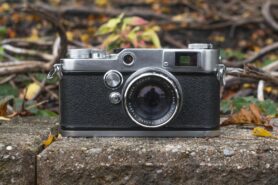






















Excellent review of an excellent Leica copy brand most have never heard of or seen. Have a IV-S, V3, and have recently been lucky enough to acquire an SD. The lenses are excellent, although very expensive and about as rare as the cameras, other than the 5cm/F2.8 and 5cm/F2 which are more plentiful and reasonably priced.
Great review. I own three Leica IIIs, Leotax, Nicca and now a Canon iib (I purchased it this week and loaded my standard Kentmere 100 for testing purposes). I am eager to purchase a Tanack IV-S, but have heard mixed reviews. The cameras look attractive, but will likely see if I can find a V3 in the next few months to add to my collection. As always, I will keep my eyes open for that affordable IV-S on ebay if it is out there……